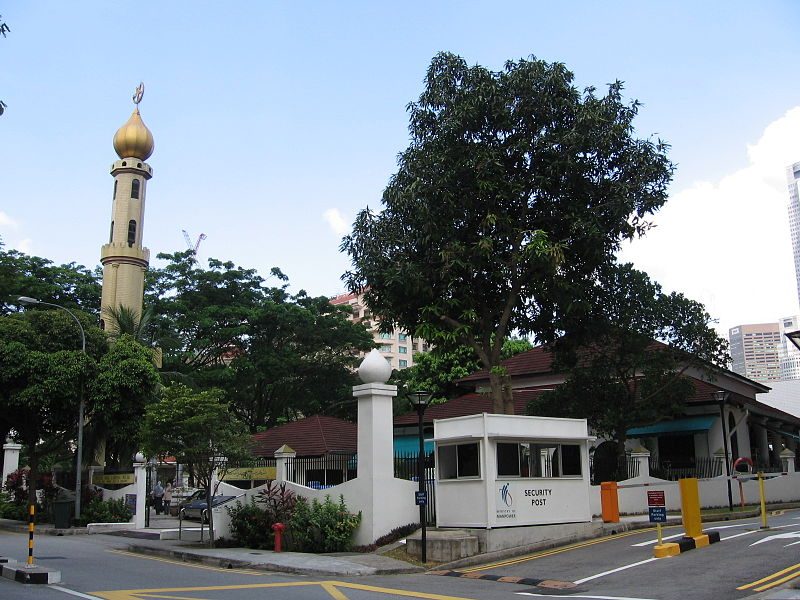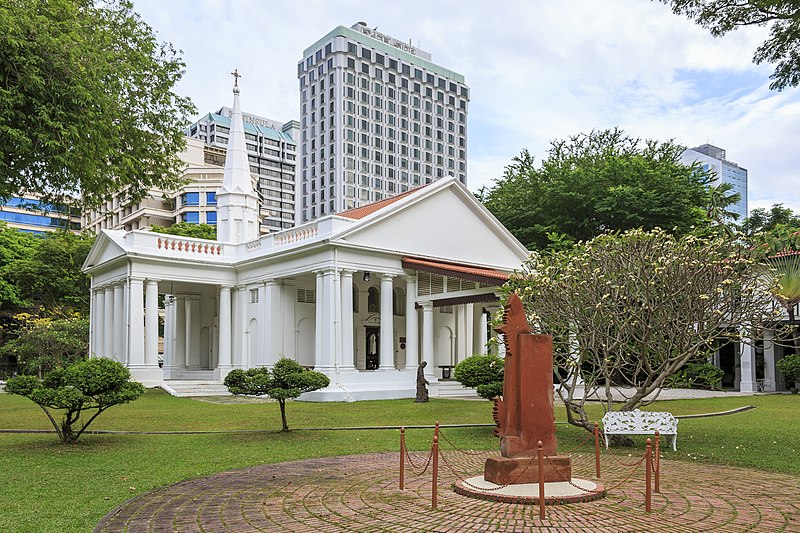
Image by DavidRockDesign from Pixabay
10 Oldest Buildings to visit in Singapore
The image of Old Singapore is all about the pre-colonial era – usually consisting of wooden kampongs, sampans and jetties.
A testament to its humble origins as a fishing village.
British colonial rule introduced structures made of bricks and concrete.
This resulted in some of the country’s historic buildings which despite Modern Singapore’s constant transformation are still standing today.
Singapore is home to a great number of historic buildings with important pasts that will definitely satisfy your inner historian and give you insight into the city‘s yesteryears.
From the oldest Chinese temple in the country to the grand architectural marvel that is St. Andrew’s Cathedral.
Singapore is definitely still full of surprises that have survived the test of time.
Both tourists and locals can do with a dose of the past as it’s always good to know something about the history of the city you’re currently in.
From the oldest government building to the first place of worship, here are the 10 oldest buildings to visit in Singapore.
1. Masjid Omar Kampong Melaka (1820)

Image by User:Sengkang from Wikimedia
Masjid Omar Kampong Melaka’s started out as a wooden Surau (Islamic assembly building) in 1820, making it the oldest mosque and also the very first place of worship in Singapore.
Syed Omar Aljunied an Arab businessman and philanthropist, established the mosque.
Sir Stamford Raffles personally welcomed him when he arrived in Singapore.
His son Syed Abdullah then financed the brick makeover in 1855.
National Heritage Board listed the mosque as a historic site in 2001.
2. Thian Hock Keng Temple (1821)

Image Jnzl’s Public Domain Pictures from Wikimedia
A century ago, Telok Ayer Street was right up against the sea before land reclamation work began in the 1880s.
The Thian Hock Keng Temple, known as the Temple of Heavenly Happiness started out as a small joss house sometime between 1821 and 1822.
Chinese immigrants, came here to burn incense in thanks to Ma Cho Po (a Taoist deity and protector of seafarers) for their safe arrival.
Boats provided some of the materials used in the temple construction. Inside, the main altar features a statue of Ma Cho Po, and other deities of luck, war and punishment.
The oldest and most important temple of the Hokkien people in Singapore, it was gazetted as a national monument in 1973.
3. The Arts House (1827)

Image by Bjoertvedt from Wikimedia
The Old Parliament House is regarded as the oldest existing government building it is now referred to as The Arts House.
John Argyle Maxwell a Scottish merchant built in 1827 as his private residence before being taken over by the colonial government.
Extensions were added in 1875, 1901 and 1909, and the architecture eventually transformed from the Palladian style to Victorian.
The building served as the Parliament House from 1959 until 1999 and was gazetted as a national monument in 1992.
It was converted into a home for performing and visual arts and has been active ever since its inception in March 2004.
4. Sri Mariamman Temple (1827)

image by user:Sengkang from Wikimedia
In the middle of Chinatown is where to find the biggest and oldest Hindu temple in Singapore.
Dedicated to the goddess of Rain.
The Sri Mariamman Temple’s roots can be traced back to 1827 when it was first built by Naraina Pillai, the first recorded Indian immigrant to enter colonised Singapore (he travelled with Sir Stamford Raffles from Penang), as a humble shed made of wood and attap.
The oldest parts of the existing brick structure date back to 1843.
Mariamman is famous for its detailed gopuram (tower gateway) and was declared a national monument in 1973.
It’s also the site of Theemidhi, a remarkable fire-walking ceremony held a week before the Hindu festival Deepavali.
5. Armenian Church (1835)

Image by CEphotos, Uwe Aranas from Wikimedia
This early 19th-century architectural masterpiece along Hill Street is the first Christian church in Singapore.
And also the first in 1909, became the first building with electricity in Singapore.
It is dedicated to St Gregory the Illuminator, the first Armenian monk.
The first twelve Armenian families who settled on the island commissioned it.
The church which was designed by prominent Irish architect George D. Coleman.
Gazetted as a national monument in 1973 and restored in 1994, the small church also doubles as a tribute to the once-influential Armenian community in Singapore including:
the Sarkies brothers who built the Raffles Hotel, Agnes Joaquim who hybridised Singapore’s national flower Vanda ‘Miss Joaquim’, and Catchick Moses who co-founded the national newspaper The Straits Times.
6. Victoria Theatre and Concert
Hall (1862)

Image by Bjoertvedt from Wikimedia
The Victoria Theatre and Concert Hall is a performing arts center in the Central Area of Singapore, situated along Empress Place.
It is a complex of two buildings and a clock tower joined together by a common corridor; the oldest part of the building was first built in 1862 and the complex was completed in 1909.
The complex has undergone a number of renovations and refurbishments.
The buildings in the complex have been used for a number of purposes.
The concert hall is used as a performance venue by the Singapore Symphony Orchestra (SSO), and the complex is managed by The Esplanade Co Ltd.
The Victoria Theatre and Concert Hall was gazetted as a national monument on 14 February 1992.
It is definitely worthwhile seeing a show or just strolling through to admire the architecture and the walls that soak up so much of the past.
7. Sri Veeramakaliamman Temple(1881)
The temple started as a shrine dedicated to the Hindu goddess Kali in 1855.
The popular Hindu temple is located in little India. It is dedicated to the goddess Kali, a powerful but benevolent figure.
The building was apparently constructed by Bengali immigrants, and completed in 1881, but like all such monuments in Singapore has gone through many extensions and renovations over the years.
Hindu deities depictions decorate the gopuram (tower entrance).
The main shrine houses a jet black statue of Kali, flanked by her sons Ganesha and Murugam.
You can spot those who have been blessed at this temple: they have white ash on their forehead, rather than the usual dark colours
8. Lu Pa Sat (1894)
A treat for the senses, Lau Pa Sat is one of the most popular hawker centres in Singapore, serving up everything from local to international fare.
But bet you didn’t know it actually started as a fish market on the waterfront in 1824 before relocating to its present location in 1894.
Lau Pa Sat remains one of the oldest Victorian structures in Southeast Asia and one of the first structures built in pre-fabricated cast iron in Asia.
Despite going through several changes, the market still stays true to its original vision and elegant old-world charm.
An iconic Singapore landmark, it was gazetted as a national monument in 1973.
9. House of Tan Teng Niah (1900)

Image by Marcin Konsek from Wikimedia
Built-in 1900, this colourful sweet house, complete with eight rooms is the last surviving Chinese villa in Little India.
It belonged to the towkay Tan Teng Niah who ran several confectionery factories in Serangoon Road and a rubber smoke-house at Kerbau Road.
The house was later restored in the 1980s for commercial use.
At the moment, it’s off-limits when it comes to entering but its exteriors make up for an eye-catching backdrop fit for the great photoshoots.
10. Central Fire Station (1908)

Image by Erwin Soo from Wikimedia
The Central Fire Station is easy to spot by its distinctive red and white facade.
It also has a watchtower and living quarters for firemen.
With fire trucks and equipment on display, as well as customised interactive stations for a close-up experience of what firefighters and rescuers go through during a mission,
It welcomes all to fully experience and understand this integral part of Singapore’s history.
Singapore’s varied charms are bound to enchant visitors to our island.
Explore its century-old temples, bustling hawker centres and lush green spaces.
Our city’s calendar of events is equally diverse and presents travellers with ample opportunities to explore, indulge and express their passions.
Planning a trip to Paris ? Get ready !
These are Amazon’s best-selling travel products that you may need for coming to Paris.
Bookstore
- The best travel book : Rick Steves – Paris 2023 – Learn more here
- Fodor’s Paris 2024 – Learn more here
Travel Gear
- Venture Pal Lightweight Backpack – Learn more here
- Samsonite Winfield 2 28″ Luggage – Learn more here
- Swig Savvy’s Stainless Steel Insulated Water Bottle – Learn more here
Check Amazon’s best-seller list for the most popular travel accessories. We sometimes read this list just to find out what new travel products people are buying.










